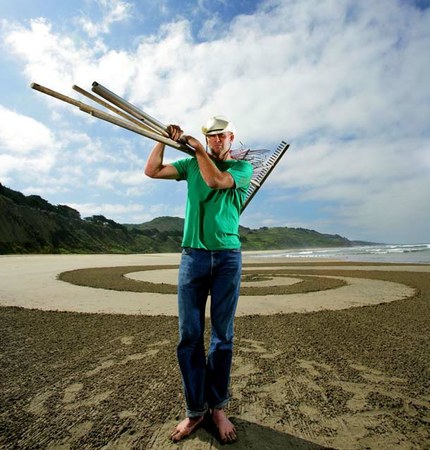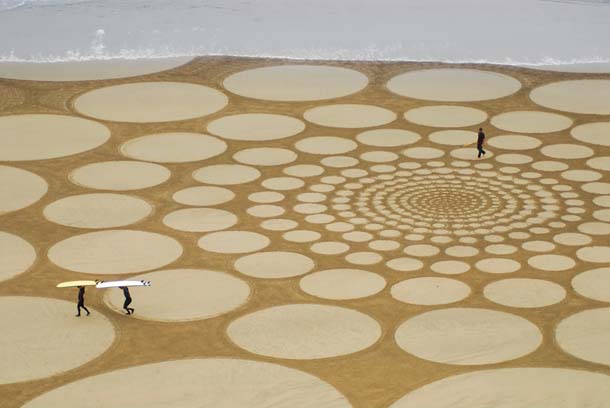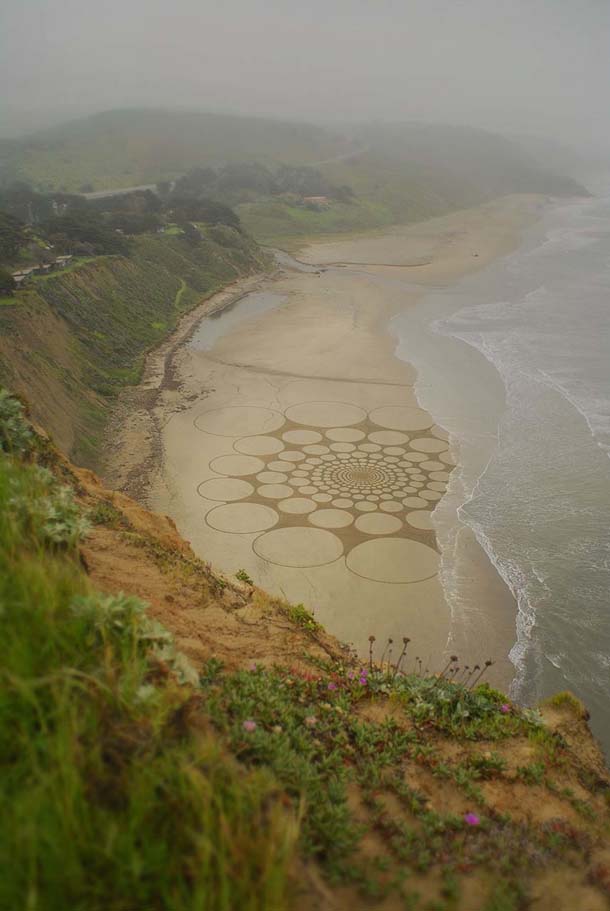There’s an aspect of the art, especially when it’s done in a public area, that people can visit, they can compose themselves within the artwork. The artwork will have some relation to the size of a person’s body. And the compositional elements provide a path by which they can explore the relationship of their body to the composition. Drawing in the sand is very human, it’s gentle and it’s grand at the same time.I went out two days ago for the first time in a long time and it was very, very soothing to me, very peaceful. And also it’s physically challenging to walk for a period of hours, and to use my strength to push the sand. It’s fulfilling to complete something. It’s difficult.
I have been doing this for almost 18 years now, and I have kind mixed feelings about it now. I have made a substantial amount of money in the last year doing commissions in different places in the world. But generally there’s no money to be made; there’s no photograph to be sold.
BN: When people, dogs, and frisbees come through, is that annoying?
DENEVAN: I consider the people something like the waves in the erosion of the drawing, meaning that I appreciate their interest and their comments, but can’t control what they’re going to be doing at the beach, with digging holes or who knows what. And I never stop anyone from playing volleyball.
BN: Of all the different art that you have done in the Bay Area, which one has been the most meaningful to you, and why?
DENEVAN: I have to say the drawings I’ve done on Ocean Beach. I really appreciate when people have come into the artwork and experienced it for themselves, and the comments that they make, and the appreciation they have for what I’m doing. It’s a little overwhelming. It’s probably why I don’t do it all that much.
BN: Most people are very enthusiastic about your work. Some have compared your work, perhaps critically, to either Christo or Goldworthy; or alien crop circles or Buddhist sand mandalas. What do you make of those comparisons?
DENEVAN: Well, the first thing that comes to mind is that it’s a similar impulse that I have to those that you listed. I think Christo and Goldsworthy, and certainly Australian Aboriginals or Tibetan Monks, are concerned with similar questions. It’s inevitable that expression is going to evolve that’s going to be personal.
BN: If you could have access to any site in the Bay Area, and do any kind of composition there, suspending the usual laws, permitting rules and social norms, where would you choose and what would you do?
DENEVAN: Something that I’ve been thinking about for a while is the salt ponds in the South Bay. When you fly in, you see the various colors that exist. What I would do is have brilliantly different colored circles, using the different times of the salt production. I’ve done a little research into that and actually, I’ve been meaning to go down there and walk around and get a feel for that whole area. I don’t think anyone would argue against that. I think it would be fun and interesting and very beautiful, with the bright colors.
BN: What are the challenges you face in your work?
DENEVAN: I’ve had people that have been drinking alcohol on the beach and they come up to me and try to ask me questions when I’m trying to concentrate.
And then I’ll go up to a high spot, and I’ll see the mark of where the conversation was, where I lost my concentration. And you can see where the drawing went off course, which I think is kind of fascinating and I can’t get mad. It would ruin it.
BN: How does your work affect the viewer’s perceptions of the local environment
DENEVAN: It touches them because it brings them closer to something I think they already know, but maybe don’t see so much in their daily life, that things – whether they’re culture or nature – are transitory. They will be transforming to something else, and therefore, personally when people are experiencing the artwork, they are recognizing their temporality, and that blends into the perception of – and the experience of – the day, and the experience of the specificity of one day, one day in one life.
BN: Is there anything else that you would like to say?
DENEVAN: I’m just excited and fascinated with the world and nature and how it is that I’m alive. I feel that when somebody walks into a sand drawing, we’re all in the same place. I mean maybe physically, walking into the sand drawing, but also in the sense that we’re human, that we can be sick, that we can die, that we can be injured; we’re all part of the physical phenomena of the world, in a temporal sense.
By Paul Epstein, Bay Nature


———————————————————————————————————
I look forward to your thoughts and comments!
Be sure to Subscribe to this blog either by RSS or Email via the forms on the top right column of the page.





